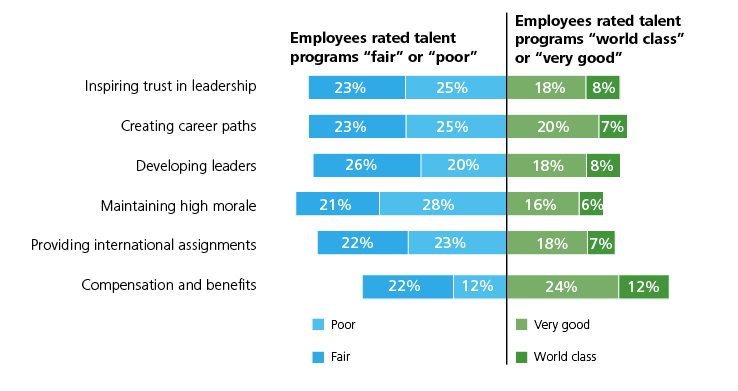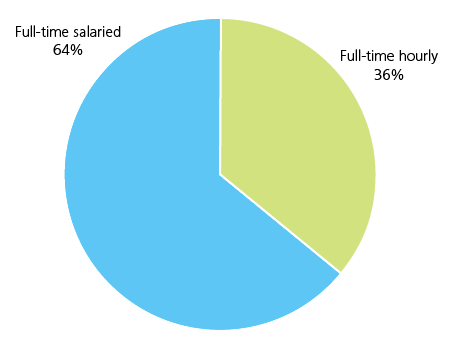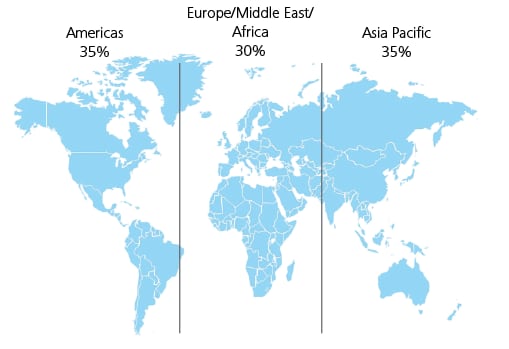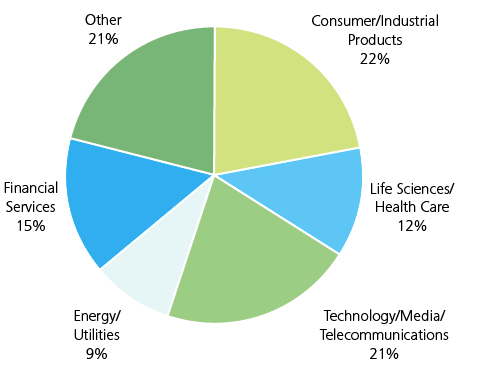Talent Edge 2020: Building the recovery together has been saved

Talent Edge 2020: Building the recovery together What talent expects and how leaders are responding
01 April 2011
Many companies are not addressing the critical needs and potential frustrations of their employees—and often do not have a realistic picture of how employees see them, according to a March 2011 survey of employees at companies worldwide. While corporate executives and talent managers may be tempted to believe the talent market has returned to normal and they can go back to “business as usual” now that the economy is growing again, our survey suggests that this strategy could leave companies on the losing side of the competition for talent.
Key findings
Many companies are not addressing the critical needs and potential frustrations of their employees—and often do not have a realistic picture of how employees see them, according to a March 2011 survey of employees at companies worldwide conducted for Deloitte Consulting LLP by Forbes Insights. While corporate executives and talent managers may be tempted to believe the talent market has returned to normal and they can go back to “business as usual” now that the economy is growing again, our survey suggests that this strategy could leave companies on the losing side of the competition for talent.
As part of the Deloitte Talent Edge 2020 series, this report examines employee attitudes to provide insights into the forces that are expected to drive the talent market over the next decade. More specifically, the survey probes divergences between the attitudes and desires of employees and the talent strategies and practices being utilized by employers. The survey also compares current employee views with the views held by employees during the depth of the recession and to the opinions of executives we surveyed in October 2010.
The March 2011 survey of 356 employees at large global companies (annual sales greater than $500 million) revealed several important trends Deloitte believes will shape the talent market in the coming decade:
Employers may risk losing the hearts and minds (not to mention the heads and hands) of employees.
With a stronger economy, more employees with pent-up desires to leave their current employers are now actively testing the job market. Rising turnover intentions, which built up slowly but steadily during the recession, may hit companies at the exact time when many executives predict talent shortages across business units that companies rely on to drive growth and innovation.
- Only 35% of the employees surveyed expect to remain with their current employers—a 10-percentage-point decrease compared to the September 2009 survey. Nearly two out of three employees (65%) surveyed are passively or actively testing the job market.
What do the 65% of employees looking for the exit sign see that their employers don’t?
The nearly two out of three employees surveyed who are exploring their career options have strong, negative views about what the job employers are doing to create challenging career paths and to open up advancement opportunities.
- Among the employees surveyed who are actively or passively seeking out new employers, 53% report the prospect of job advancement or promotion would persuade them to stay with their current companies. A majority or near majority of employees “on the market” rate their companies’ efforts at creating career paths, developing leaders, and retaining top performers as “fair” or “poor.”
Companies that adapt their talent and retention strategies to meet generational desires will be rewarded, while those that do not could find themselves at the losing end of the competition for talent.
Targeting talent strategies by generation and gender helps keep teams intact.
Both turnover triggers and retention incentives appear to vary significantly across employee generations, with differences emerging by gender. Companies that adapt their talent and retention strategies to meet the unique expectations and motivations of different employee populations will likely be rewarded, while those that do not could find themselves at the losing end of the competition for talent.
- When it comes to ranking the top turnover triggers, surveyed Baby Boomers rated “lack of trust in leadership” at the top of their list at 32%, while both Generation X and Millennial employees placed “lack of career progress” first at 38% and 30%, respectively.
- The findings also revealed that surveyed men rate “lack of compensation increases” at the top of their top turnover trigger list at 27% (compared to 14% of women), while women placed “excessive workload” first at 31% (compared to 15% of men).
Companies that lift their game to deliver “world-class” talent programs will likely be rewarded.
Very few employees define their employers’ overall talent efforts as “world-class” or even “very good”—and the same lack of confidence holds true when it comes to key talent retention strategies. However, based on survey findings, employers that lift their talent efforts will likely be rewarded with employees who are more satisfied with their jobs and career prospects (and who are far more likely to remain with their current employers).
- Only 6% of the employees surveyed rate their companies’ overall HR and talent efforts as “world-class,” while more than four in ten (43%) called them “fair” or “poor.” Not surprisingly, employees who describe their companies’ talent programs as “world-class” or “very good” are nearly twice (42% to 23%) as committed to remaining at their jobs than employees who work at companies with “fair” or “poor” talent efforts.
Employers may risk losing the hearts and minds of employees
Imagine if a company could count on keeping only a third of its customers next year. The discovery would set off alarm bells inside every C-suite office and trigger emergency meetings, strategy reevaluations, and demands for improvement. Substitute the word “employees” for “customers” and that may be the position that many companies face today.
If alarm bells are not going off, maybe they should.
Among employees surveyed in March 2011, only 35% expect to remain with their current employers
Figure 1. Are you staying or going?
Among employees surveyed in March 2011, only 35% expect to remain with their current employers, compared to 45% who were committed to their employers during the recession in 2009 (see figure 1). In addition, by a margin of more than 2:1 (45% to 20%), employees are more likely to predict an increase rather than a decrease in employee turnover during the next year.
Digging deeper: Survey findings suggest that companies may be at a greater risk with regard to retaining female employees. Women appeared more likely than men to be actively looking for new employment in the next 12 months (55% of women vs. 41% of men). Men, on the other hand, were more likely to be passively looking (24% of men vs. 12% of women).
When it comes to retaining talent, many employers risk losing the battle for the hearts and minds (not to mention the heads and hands) of their employees. Nearly half (49%) of the employees surveyed have been seeking, plan to seek, or are currently seeking new employment. Another 21% are exploring new options by posting their resumes online or keeping an open mind about calls from corporate recruiters (see figure 2).
Employees’ increasing restlessness coincides with employer concerns about losing critical talent. Employers are right to be worried.
Academic research indicates that 44% of employees are likely to act on their turnover intentions.1 With 65% of employees looking to leave their current positions, a total of 29% might actually walk out the door (0.65 x 0.44 = 0.29). Moreover, in Deloitte’s October 2010 survey of executives, 56% predicted a scarcity of leadership talent, while nearly three in four (72%) expected talent shortages in R&D.
Figure 2. Are you planning to look for a new employer?*
Red flag for employers: Is the balance of power in the job market shifting from employers to employees?
According to our survey, more than one in five employees (21%) has posted their resumes online or are utilizing social media tools to keep their career options open. While employers spent the recession hunkered down and focused on cutting costs, the job market has been slowly evolving, making it easier for employees to grab control of the market from employers.
In addition, social media sites like Facebook, Twitter, and LinkedIn open up a new, highly effective method for job-seekers and employers to connect. According to placement firm Challenger, Gray & Christmas, social networking sites now provide the second-most effective way for job-hunters to find new work, falling only behind traditional networking.2 Cachinko, a social media recruiting solutions company, claims that social media sites are driving employee empowerment because of their ease, efficiency, and exploding reach.
Cachinko recently reported that LinkedIn has 85 million members; Twitter has 175 million registered users; and Facebook has over 500 million active users, over half of whom check their Facebook accounts each day. From an employer’s perspective, social media provides cheap access to a seemingly limitless talent pool. And for employees, exploring new career options and looking for a new job has never been easier, more fun, or more empowering.3
Nearly two-thirds (65%) of the employees surveyed are looking for the exit sign, or they are at least open to a career move. What do those 65% see that employers don’t?
- Uncertain career paths: Based on our survey, well over half of the employees planning to leave their current employers (57%) believe their companies do a “fair” or even “poor” job of creating career paths and challenging job opportunities, compared to only 23% who rate this key talent metric as “excellent” or “very good”—a vote of no confidence greater than 2:1.
- Little leadership development: Our survey indicates that 50% of the employees who do not expect to stay at their current employers rate their companies’ leadership development programs as “fair/poor,” against 21% who rate them as “excellent/very good.”
- Lack of trust in leadership: Of survey respondents, only 23% of employees planning to depart believe their companies effectively inspire trust in leadership, compared to the 57% who rank these efforts as “fair/poor.”
Surveyed female employees appeared less impressed than men by their companies’ ability to inspire trust and confidence, with 35% of the women rating this ability as “poor,” compared to 22% of men.
- Difficulty retaining top performers: Survey results show that of those employees who expect to depart, 50% believe their companies are doing a “fair/poor” job retaining top performers, compared to just 23% who label retention efforts in this area as “excellent/very good.”
- Inadequate training programs: Nearly half of the employees surveyed (48%) who plan to leave their current jobs believe their companies are doing a “fair/poor” job managing and delivering effective training programs; just 24% rate training programs as “excellent/very good.”
Employees who are looking to leave believe key corporate talent programs at their current companies are seriously lacking.
What is driving talent out the door?
Digging deeper: Employers appear to be connecting best with their youngest employees. Nearly three in four Millennials (74%) believe their employers effectively communicate the companies’ strategic direction, compared to less than half of Baby Boomers (47%) and 50% of Generation Xers.
The key drivers of turnover have remained remarkably stable as employees and their companies have transitioned from a recession to recovery. When employees were asked to rank the top factors that would lead them to seek new employment, “lack of career progress” topped the list at 28%. This was followed by “lack of compensation increases,” “lack of job security,” and “lack of trust in leadership,” each at 24%. These factors also ranked as the top departure drivers in Deloitte’s September 2009 Managing Talent in a Turbulent Economy employee survey.
While many companies might expect morale to strengthen along with the economy, employees have a mixed reaction. Of the employees surveyed in March, 42% report that morale has indeed increased over the past 12 months, but a strong 36% believe morale has decreased.
Digging deeper: Respondents who have been out of work at some point in the past three years are casting a wary eye toward current employers. Just over a third (34%) of these workers cite the lack of job security as a reason to look for a new job—ten percentage points higher than overall survey respondents. They may also consider their current job to be just the best option available at the moment, not a long-term position—30% would leave current employers for new opportunities, eight percentage points higher than overall responses.
Opinions on morale, according to survey respondents, appear to differ between hourly and full-time salaried employees. The majority of hourly employees (59%) believe morale has improved or significantly improved, whereas only 31% of salaried employees hold this view. What’s more, almost half (45%) the salaried employees believe morale has either decreased or significantly decreased, a view held by just over one-fifth (22%) of hourly employees.
Examining employee morale from a global perspective, however, reveals a different picture. In the Asia Pacific and Europe, Middle East, and Africa (EMEA) regions, employees surveyed are reporting a revival of morale, with 62% and 49% of employees, respectively, responding that morale has improved over the past year. In the Americas, however, the outlook is not so bright. Only 23% of the employees surveyed report that morale has increased, leaving the Americas lagging behind the rest of the world (see figure 3).
Figure 3. Examining employee morale from a global perspective
One possible factor depressing employee morale in the Americas and beyond—even as the macro-economic environment improves—may be poor communication about corporate strategy and direction. While 57% of the employees surveyed agreed their HR/talent managers did an effective job communicating, a significant 40% found company communications lacking.
Slowing down the revolving door and turning it in your direction
What should employers do to slow down the revolving door that may be threatening an exodus of talent from their companies? Even more interesting, what should companies committed to winning the competition for talent do to turn the revolving door in their favor? Perhaps not surprisingly, the top retention incentives identified by employees present a near-mirror image of turnover drivers, providing executives and talent managers with a clear picture of the most effective talent retention strategies.
Digging deeper: Asked to rank the incentives that would be most effective in keeping them with their current employer, men appeared to focus on financial incentives. Women, on the other hand, were more likely to seek recognition. Among men, 42% said “additional compensation” would keep them from leaving, and 39% cited “additional bonuses or other financial incentives” as retention incentives. Among women, only 27% cited “additional compensation” as an incentive, and only 19% cited “additional bonuses.” Meanwhile, 40% of women said “support and recognition from supervisors or managers” would be a valuable retention method, compared to just 28% of men.
When asked to list the top three retention incentives, survey respondents ranked “promotion/job advancement” first at 53%, followed by “additional compensation” at 39%, and “additional bonuses or other financial incentives” at 34% (see figure 4).
Financial incentives are a perennial talent retention favorite, but companies can improve their talent retention efforts through non-financial incentives as well. Boosting employee support/recognition from their managers was ranked as an effective retention tactic by a strong 30% of the employees that Deloitte surveyed.
Figure 4. Departure drivers and retention incentives
Job advancement expectations have also jumped considerably, as the recession has faded and the recovery has taken hold. In 2009, 28% of the employees surveyed listed job advancement expectations as a top retention incentive. In March, that number had grown to 53%—a jump of 25 percentage points in 18 months.
Red flag for employers: Keep a laser-like focus on creating clear career paths and challenging job opportunities.
More than half (53%) the employees that Deloitte surveyed believe companies only do a “fair” or “poor” job of creating career paths and providing challenging job opportunities. For employees looking for jobs, challenging job opportunities really do matter.
Talkin’ ’bout my generation
In examining the data related to turnover triggers and retention incentives, one fact becomes crystal clear: companies that deploy a “one-size-fits-all” retention strategy will have a hard time competing in the intensifying worldwide competition for talent (see figure 5). Different generations have vastly different goals, expectations, and desires—and employers should tailor and target their talent strategies to address every employee group, from Baby Boomers to Generation Xers to Millennials.
Different generations appear to have very different goals, expectations, and desires—and employers must tailor and target their talent strategies to satisfy every employee group, from Baby Boomers to Generation Xers to Millennials.
Baby Boomers feel frustrated and let down.
Among the employees surveyed, Baby Boomers expressed the strongest discontent with their employers and the greatest frustration that their loyalty and hard work has been neither recognized nor rewarded.
- More than half of the Baby Boomers surveyed (51%) report that morale at their companies has dropped over the past year.
- Less than half (47%) believe their companies successfully communicate their corporate strategies.
- Four in ten Baby Boomers (41%) labeled their companies’ ability to inspire trust and confidence in leadership as “poor.”
- Among Baby Boomers, 32% cited “lack of trust in leadership” as a key turnover trigger—making it their top reason to leave and the highest selection of any generation. Baby Boomers also listed “lack of job security” and dissatisfaction with managers/supervisors as prime motivators that could cause them to leave their current companies.
What will it take to keep Baby Boomers satisfied—especially at a time when companies recognize the need to retain key leaders and keep Baby Boomers on the job longer? While all generations ranked “promotion/job advancement” as the number one retention incentive, for Baby Boomers it was less of a priority. Just half (50%) cited promotions when asked to pick their top potential inducements, compared to nearly two-thirds of Generation Xers (see figure 5).
Figure 5. Top three most effective retention initiatives by generation: Executives vs. employees
More than four in ten Baby Boomers surveyed (43%) wanted greater support and recognition from managers/supervisors, making it their second highest retention incentive. These findings represent a shift in Baby Boomer attitudes since the September 2009 survey, where 41% of Boomers cited “strong leadership” as the most effective retention incentive, followed by “additional financial incentives” (40%) and “additional compensation” (36%).
Generation X wants to move up or move out.
Generation X employees are by far the group most likely to be looking at exit strategies from their current jobs (see figure 6). Many Gen Xers surveyed appear frustrated that they are bumping up against the “gray ceiling—with their career paths blocked by Baby Boomers who are not moving out of the workforce.
- Nearly four in ten Gen Xers surveyed (38%) report they are currently seeking a new job or have been actively looking over the past year.
- Only 28% of Gen Xers expect to stay with their current employers—suggesting many companies can expect a significant exodus among employees they were counting on to become future leaders.
- One of the biggest talent challenges many companies face is opening up career paths for the next generation of corporate leaders. “Lack of career progress” was the clear, number one exit trigger for Generation X, at 38%. “New opportunities in the job market” and “lack of compensation increases” lagged well behind at 28% and 26%, respectively.
Figure 6. Employees seeking new employment by generation*
The “move-up-or-move-out” attitude of Generation X was also evident when Deloitte asked employees to rank the top three retention incentives that would persuade them to stay with their current employers. For Gen X, “promotion/ job advancement” was the clear first choice at 64%, followed by “additional bonuses or financial incentives” at 41% and “additional compensation” at 33% (see figure 5).
Red flag for employers: Retirement out of reach.
Companies should consider ways to integrate older workers effectively into the workforce. Among the Baby Boomers surveyed, nearly half (48%) believe that they will continue working past age 65, compared to just 24% of Gen Xers and 11% of Millennials. More than one in every ten Baby Boomers (13%) predicts he will work past 70. These demographic changes in the workplace will likely require companies to create flexible approaches to work, retirement, learning, and education. According to the survey, workplace flexibility and rewards are the most important incentives for keeping Baby Boomers working and content. They tend to desire flexible work arrangements (38%), additional bonuses or financial incentives (29%), and additional compensation (27%). However, as the survey suggests, employers, by and large, have not been effective in creating career options for people working past 65, even though many employers want their experience and will need their skills. Addressing the issue of how to engage older employees should be considered a talent priority.
Figure 7. When considering an employer, how important is the organization’s commitment to the following?
Along with financial incentives, Millennials seek a new corporate culture with progressive values.
Millennials share a desire to pull themselves up the corporate ladder and want the financial rewards that come with that career progress. But when considering employers, they also seek a corporate culture that aligns with a different set of values than their more experienced colleagues.
- Nearly one in three Millennials (32%) is about to begin looking for new career opportunities in the next 12 months. Like Generation X, Millennials also ranked “lack of career progress” as their top exit trigger, but less than their older colleagues (30% compared to 38% for Gen Xers). “Lack of compensation” increases (28%) and “lack of job security” (22%) round out the top three departure drivers.
- Millennials have a sharply different idea of what makes for a strong corporate culture than other generations. When asked, for instance, how important a company’s commitment to “sustainability” is, nearly two in three rated it “very important” compared to just one-in-three Baby Boomers (35%). By more than 2:1 (32% to 13%), Millennials were more likely to consider their employers’ commitment to “corporate responsibility/volunteerism” very important than were Baby Boomers. Millennials were also nearly three times more likely to call a “fun work environment” important compared to Baby Boomers (55% to just 19%) (see figure 7).
Employers need to lift their game to deliver world-class talent programs
Talent managers face a number of serious challenges—from increasing employee frustration over the lack of clear career paths to the rise of Internet and social media tools that make it easier for key talent to shop for better opportunities elsewhere. Addressing the challenges is a critical job—but according to the overwhelming majority of employees Deloitte surveyed, talent programs at most companies are falling short.
Digging deeper: Leaders of Americas’ based companies trail those in the rest of the world when it comes to winning their employees’ trust. More than a third (35%) of the Americas’ employees surveyed said a “lack of trust in leadership” would drive them to look for a new job in the year ahead. Just 14% of EMEA workers and 21% of Asia Pacific workers share the same view.
Only a scant 6% of employees who participated in the March survey described talent programs at their companies as “world-class.” By a margin of more than 7:1 (43% to 6%), employees were more likely to rate their companies’ talent programs as “fair” or “poor” than “world-class.” Even broadening the definition of “successful” talent programs to include companies employees believe are doing a “very good” job, nearly three in four companies (73%) fail to clear the bar.
Given the dim view most employees have of their companies’ overall talent efforts, it is not surprising that companies did not fare much better when employees were asked to grade specific talent programs.
By a margin approaching or exceeding 2:1, employees were more likely to view many talent programs as “fair” or “poor” than “world-class” or “very good”—including developing leaders (46% “fair/poor” to 26% “world-class/very good”); maintaining high morale (49% “fair/poor” to 22% “world-class/very good”); inspiring trust and confidence in leadership (48% “fair/poor” to 26% “world-class/very good”); creating career paths and challenging job opportunities (48% “fair/poor” to 27% “world-class/very good”); and providing career mobility and international career assignments (45% “fair/poor” to 25% “world-class/ very good”) (see figure 8).
The only major area where employees gave their companies relatively high marks was providing competitive compensation and benefit packages, with 36% calling their companies’ efforts “world-class” or “very good” compared to 34% who rated them “fair” or “poor.”
Figure 8. Employee ratings of their companies’ talent programs
Digging deeper: Financial Services employees give poor marks to their companies’ HR/Talent programs. A solid majority—57%—rated their employers’ overall talent efforts as “fair” (44%) or “poor” (13%).
Strong talent programs = better workforces, better workplaces, stronger companies
So, what really works when it comes to keeping employees committed to their companies and satisfied with their careers? The 35% of employees surveyed who plan to stay with their current employers agree on one clear factor: strong talent programs. Companies with the most effective talent programs share several critical traits that offer compelling lessons.
Create clear career paths.
Of the employees surveyed who plan to remain with their employers, 33% believe their companies are effectively creating challenging job opportunities and clear career paths, compared to 23% for employees who are looking to leave their current jobs.
Develop a robust leadership pipeline.
Based on our findings, by a margin of 35% to 21%, employees committed to their employers believe their companies are doing a “world-class/very good” job of developing leaders through internal and external talent programs.
Inspire trust in leadership. Survey results indicate that a third (33%) of employees who want to stay with their current companies believe their employers are “world-class/very good” at inspiring trust and confidence in corporate leadership, compared to just 23% among employees looking to leave.
Focus on top performers.
Survey results indicate by nearly 2:1 (44% to 23%) committed employees report their companies do a superior job of retaining top talent versus those looking for a new employer.
Communicate effectively.
Does your company do an effective job communicating with employees? Almost three-quarters (72%) of the employees surveyed who are sticking with their employers believe that their employers do a good job communicating with them—22 percentage points higher than employees exploring new career options.
Companies following this roadmap are reaping significant benefits and positioning themselves to win as the competition for talent intensifies.
Overall, employees who enjoy “world-class” or “very good” talent programs are happier with their jobs and the development of their careers than those whose organizations have “poor” HR programs.
- Committed employees. Surveyed employees with “world-class” or “very good” talent programs are more likely to remain with their current employer than those with “fair” or “poor” programs (42% vs. 23%), and they are less likely to even be passively considering new employment (14% vs. 32%).
- Strong employee morale. Survey respondents who describe their companies’ talent programs as “world-class” or “very good” are far more likely to report higher morale over the past year compared to those who rate their HR program as “fair” or “poor.” When asked how morale had changed over the past 12 months, a full 72% of those with strong talent programs said it had “improved” or “significantly improved,” compared to only 16% of those with “fair” or “poor” HR programs.
- Effective communication. Companies with “world-class” or “very good” HR efforts are much more likely to be effectively communicating critical issues to their employees. Nearly nine in ten (89%) employees surveyed who rate their talent programs as “world-class/very good” credit managers for effectively communicating their companies’ strategic direction over the past year. It is a mirror image for employees who rate their HR “fair/poor;” 81% said their managers had not communicated effectively during the past 12 months.
- Solid trust. According to our survey findings, employees who rate HR efforts highly also believe their organizations were transparent during times of economic uncertainty. These employees gave their companies “excellent/world-class” (23%) or “very good” (34%) marks—57% combined. The opposite was true for workers with fair or poor HR. More than three-quarters (76%) of these respondents said their employers did only a “fair” (35%) or “poor” (41%) job of remaining transparent.
- Important values. Workers benefitting from exceptional talent programs have higher expectations from their employers when it comes to corporate values and commitments.
- When considering an employer, nearly all—92%—of the surveyed employees believe their organization’s commitment to sustainability is “important” (33%) or “very important” (59%).
- They also highly value an employer’s commitment to corporate responsibility—83% said it was “important” (49%) or “very important” (34%)—and for diversity and inclusion, 79% called it “important” (42%) or “very important” (37%).
- Future leaders. A strong talent program includes delivering good career development plans to employees. A large majority of survey respondents with highly rated HR programs described as “very good/world-class” their companies’ performance in developing leaders and creating career paths (60%), as well as in managing and delivering training programs (59%).
Building the recovery together
Deloitte’s Talent Edge 2020 employee report reveals clear, actionable strategies that employers can implement to deliver world-class talent programs and keep top talent committed to their jobs, excited about their career prospects, and confident in their corporate leadership. Winning companies are targeting talent efforts to each generation, creating clear career paths, and ensuring employees have challenging job opportunities.
Executives around the world are predicting shortage of key talent in critical business units. Firms will separate themselves from the competition if they step up their talent programs now and refine their strategies to engage with workers and focus on specific employee needs.
Survey demographics
For Deloitte’s Talent Edge 2020 employee report, Forbes Insights surveyed 356 employees working at large companies with annual sales of over $500 million. More than three in four (78%) work at companies with more than $1 billion in annual sales (see figure 9).
Approximately three-quarters of survey participants were men (78%) and 22% were women (see figure 10).
Approximately a third of the survey participants were drawn from each generational group: 33% Baby Boomers (ages 48 to 65), 32% Generation X (ages 32 to 47) and 33% Millennials (ages 31 or younger). The remaining 2% were ages 66 or older—too small a sample size to be included in any of the survey’s findings (see figure 11).
Figure 9. Company revenues during the most recent fiscal year
Figure 10. What is your gender?
Figure 10. What is your gender?
Participating employees were also distributed across hourly (36%) and salaried roles (64%) (see figure 12).
Participating employees were evenly dispersed throughout the world’s major economic regions: 35% in the Americas, 35% Asia Pacific, and 30% in Europe, Middle East, and Africa (see figure 13).
Every major industry was represented, led by Consumer/Industrial Products (22%), followed by Technology/Media/Telecommunications (21%), Financial Services (15%), Life Sciences/Health Care (12%), and Energy/Utilities (9%)(see figure 14).
Figure 12. What best describes your role?
Figure 13. Respondents by location
Figure 14. Company industries


















